Myrtle’s Nest-egg Contributions Grow at NIEHS
Myrtle’s Nest-egg Contributions Grow at NIEHS
By the Site Ecology Team (SET) and Wildlife and Industry Together (WAIT)
April 13, 2015


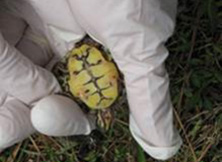
River cooter (Pseudemys concinna) Immature(s)
All pictures of our hatchlings and nest are courtesy of the authors.
Myrtle the Turtle emerged onto the public stage back on June 13, 2014 when she bravely traveled nearly 840 feet from Discovery Lake, across campus to deposit her clutch of eggs near the South Park parking lot. The nest site was in an old Russian Sage plant bed above the employee sidewalk, in full sun, with an open exposure, simply lovely. That area was immediately cordoned off and designated as an Environmental Preservation Site for the protection of this Eastern River Cooter’s offspring. With soil temperatures (June through September) averaging 76.0oF and mean air temperatures of 76.6 degrees Fahrenheit, conditions were right for a September 11th – 21st hatch (90-100 day incubation). Even though the turtles should have hatched in September, there was no guarantee that they would emerge at that time. As you might recall, the EPA Early Learning Center had to wait until the next spring for their turtles to leave the nest and those eggs were deposited earlier in June than ours. As luck would have it, our turtles didn’t emerge in September so we had to wait and wait and wait, hoping the eggs hatched and the baby turtles would be fine where they were. There was concern that the soil would settle around the hatchlings and they would be encased in dirt. Would they have a chance to free themselves from the egg remnants?
It was obvious (a no brainer actually) as we watched Myrtle deposit her eggs that she was the maternal parent, but “Who(s)’s Your Daddy?” The male’s role is more elusive, for he’s known to eat, bask in the sun, and inseminate the female, while her role is to find and dig a nest site, deposit the eggs, cover them, mask the location, then get back to the water, all while avoiding predation or being seen. Neither of the parents stays near the nest site nor participates in the care or protection of their young. Little can be said about the father(s) identity except by genetic analysis of the young. Even then, there must be gDNA from the female and biological father(s). Did I say Fathers? Oh. Most aquatic turtles are polygamous creatures and a male may mate with multiple females. It’s unclear if the female or the male chooses his or her partner(s) but females may accept multiple partners. To make things even more intriguing, the female can store viable sperm in an organ called “a tubule” for up to four years (usually two) and not need successful matings the year she lays a clutch of eggs. It’s also possible that sperm from two different males fertilize eggs in the same clutch. There is survival potential if one male were sub-fertile. Regardless of these findings, the babies were expected to be really cute and adorable.
NOW for the Rest of the Story
On Thursday, April 9, 2015, the local weather report called for overcast skies, with a chance of rain, sometimes heavy, throughout the day. No ALERT mentioned a possibility of turtles. After a rainy early morning nest check, all seemed as it had since September, but today would be different. For today, the baby turtles would leave the nest. Possibly the warm temperatures with the rain allowed them to break free. From the shape of the exit hole, they all came out in the same orientation. We didn’t need to worry about encasement, for below the hole was a flask-shaped chamber and all the old egg fragments were below the floor of this chamber. It would appear that the turtles hatched and were able to move around enough to create open space for themselves. All eggs did hatch. It appeared that rainwater entered the open chamber, and could have helped buoy up the turtles making exiting easier.
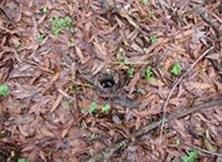
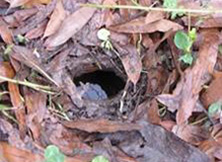
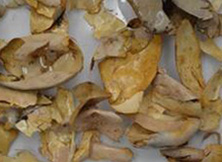
Of Myrtle’s nine eggs, seven baby turtles were observed. Six were released at the lake’s edge as shown here. Hopefully the other three made it to the lake.
The river cooter is one of the turtles often sold in the reptile trade. “In 1975 a U.S. Food and Drug Administration (FDA) regulation banned the sale (for general commercial and public use) of turtle eggs and turtles with a carapace length of less than 4 inches (100 mm)” [Source]. However, “Many stores and flea markets still sell small turtles due to an exception in the FDA regulation which allows turtles under 4 inches (100 mm) to be sold "for bona fide scientific, educational, or exhibition purposes, other than use as pets”.
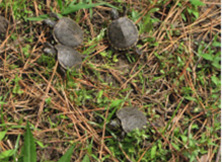
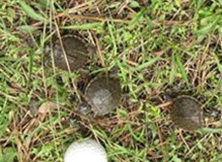
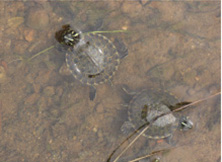
Young turtle care is fairly easy as long as near natural conditions are provided: a 20-30 gallon tank equipped with a constant source of water, a basking rock with UVB light and a heat lamp. Cooters are primarily herbivorous, but enjoy a good insect snack occasionally. Rely on the reputation of a licensed wildlife provider to insure the legality and health of your purchase. Veterinary care and annual checkups should be performed and aren’t cheap, with the threat of Salmonella a real concern, especially when adults or children handle the turtle and don’t wash up well.
Acknowledgement: The use of the Turtle’s pictures and their comments was by mutual consent of all parties.
References
DISCLAIMER: The following YouTube sites are referenced for educational purposes only, not as an endorsement, guidance, or recommendation by the authors or NIEHS
- The Turtle Source
- Turtles intrastate and interstate requirements; FDA Regulation, Sec. 1240.62, page 678 part d1.
- YouTube: Baby River Cooter turtles just hatched!
- YouTube: Baby Turtle Hatchlings Being Dug Up Live



